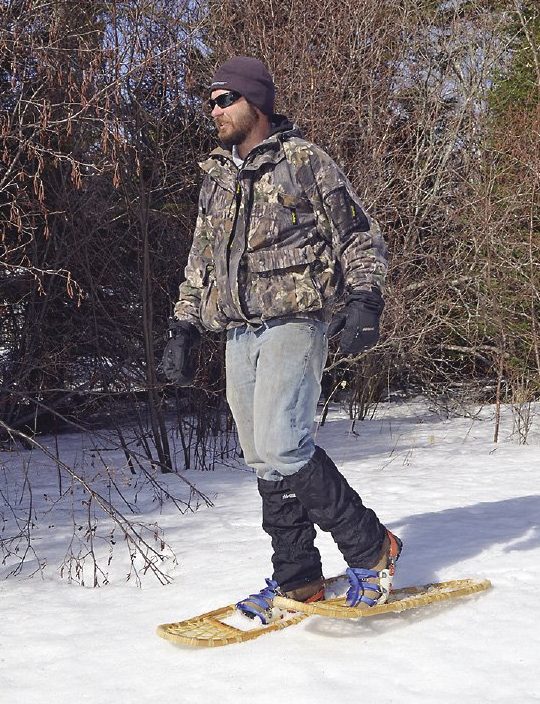Snowshoeing is a popular recreational activity along the North Shore in winter. Although most folks these days strap on a pair of snowshoes to take a leisurely hike down a trail, their original use was purely functional: to make travel through deep snow easier.
It’s impossible to say how long snowshoes have been in existence, but we can trace their history back to central Asia about 6,000 years ago. Primitive people looking for a way to travel through deep snow with less difficulty invented rudimentary snowshoes consisting of a solid piece of wood strapped to each foot. As ancient tribes spread out, this technology moved with them and evolved. Tribes that moved into what is now northern Europe modified the original snowshoe design into what became the Nordic ski. Other tribes moved northeast, eventually crossing the land bridge (probably on snowshoes) from northeastern Asia into North America. As these tribes spread out into different regions, the snowshoe evolved. Specifically, snowshoes adapted to the type of snow in the region (powdery or wet) and to the terrain (open or forested). Much of the evolution of snowshoes then took place in snowy regions of North America.
Craftsmen used a variety of woods to make snowshoe frames, depending on what was available, but to this day, most makers use ash, which has a straight grain and is strong, yet flexible. Upon soaking or steaming, ash can be bent into the round shape desired for making snowshoes.
The traditional lacing material, called babiche, was made from rawhide or sinew of moose, caribou or deer. In areas of deep, powdery snow the lacing was woven tightly. Where snow was heavier and wet, a looser weave worked fine. As such, the preferred snowshoe style could even vary with the seasons, going from a fine weave during the dry snows of mid-winter to a looser weave during the spring melt.
Many snowshoe types emerged over the years, again, depending on geography, but four main styles developed, with slight variations.
OJIBWA
Ojibwa snowshoes are made of two pieces of wood lashed together at the front and back. This gives them a pointed, upturned toe and a long, pointed tail. Ojibwas work well for breaking through crusty snow and for parting brush.
ALASKAN
Alaskan snowshoes are the longest style. They are narrow with rounded, upturned toes and distinctively long tails. They are designed for walking on deep snow in open terrain.
MICHIGAN (HURON)
Michigan snowshoes are the classic teardrop-shaped design with a medium width and length. They have rounded, upturned toes and a long tail. They are good all-around snowshoes that perform well in a variety of snow conditions and terrains.
BEAR PAW
Bear Paw snowshoes are quite wide and almost round. They have no tail, and thus, move easily through brush. One drawback is their width can make walking awkward, as the wearer has to walk with a wide stance.
Many people still use traditional wooden snowshoes (although the babiche webbing is usually replaced by nylon shoelace material). However, modern designs are made of lightweight aluminum and the webbing is replaced by a thin, solid sheet called decking. Decking is made of Hypalon, vinyl or poly-coated nylon. In addition, aluminum snowshoes have metal crampons, which give you traction, especially when traversing hills. The decking from modern snowshoes gives more flotation, so the overall size of the snowshoe is smaller.
THE SCIENCE BEHIND THE SNOW
The decking or webbing of snowshoes helps you float above the snow to some degree at any time. Simply put, the wider footprint of a snowshoe won’t sink in as deeply as your own foot. But as you’ve probably experienced, depending on snow conditions, some days you sink more; some days less.
If you really want to experience snowshoeing at its finest, pick your days. The best snowshoeing comes on a cold morning after a sunny, above-freezing afternoon. Afternoon sun on, say, a 35 F. day softens the snow. If overnight temperatures dip below freezing, you’re in for some perfect ’shoeing conditions. Those cold overnight temperatures freeze the soft, upper portion of the snow, creating a crust. When that crust forms, it’s sometimes possible to walk right on top of the snow, sinking in no more than you would on a concrete sidewalk. But don’t get carried away, tromping too far on that perfect crust. If temperatures warm again, the snow may soften and you’ll sink through, making for a long, agonizing return trip!
Late winter often produces the best snowshoeing conditions because increasing day length and more-direct sunlight generates more thawing. Under ideal freeze/thaw conditions, stay in sunny areas and avoid the shade of trees. Sunny areas allow the snow to soften, then re-freeze, forming that crust. It’s often possible to stand on top of the snow in the open, while breaking through in the shade of trees just feet away.
Also, keep away from fallen trees, rocks and other objects that can retain heat. Walking too close to them could cause you to break through.
Snowshoes have been around for thousands of years. Although they were invented for function, today, most people use them recreationally. Weather you go with traditional wooden models or high-tech aluminum ’shoes, once you strap on a pair, you’ll see why snowshoeing remains so popular.






